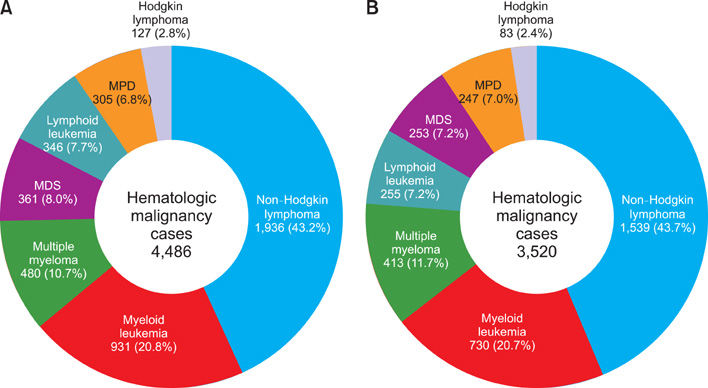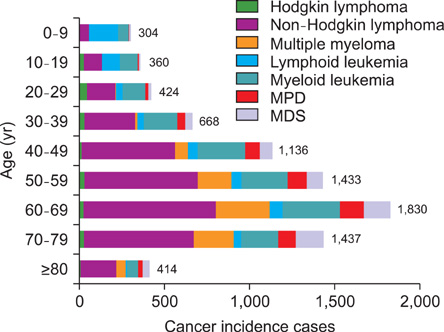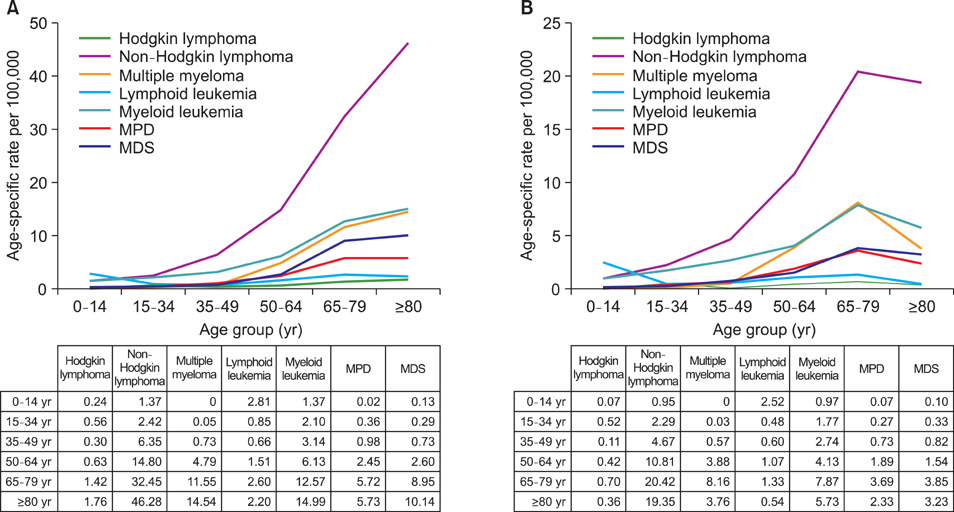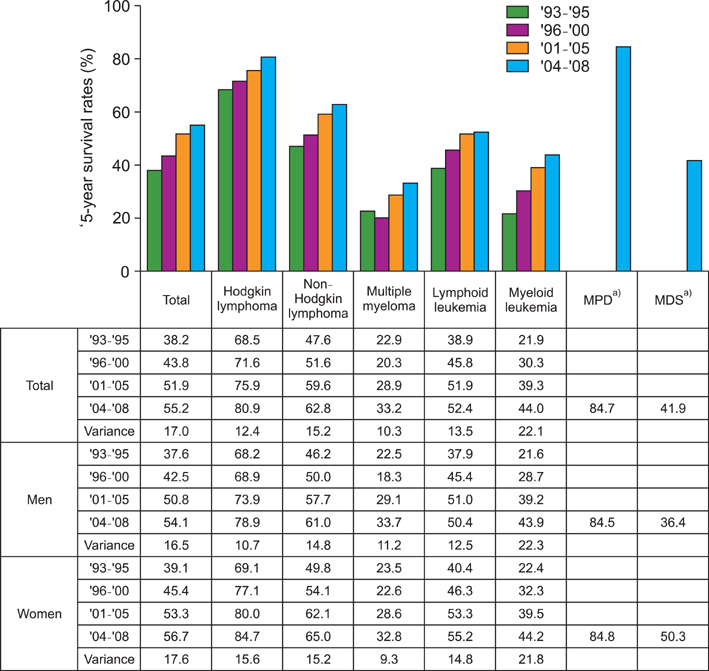Statistics of hematologic malignancies in Korea: incidence, prevalence and survival rates from 1999 to 2008
- Affiliations
-
- 1Center for Pediatric Oncology, National Cancer Center, Goyang, Korea.
- 2The Korea Central Cancer Registry, Division of Cancer Registration and Surveillance, National Cancer Center, Goyang, Korea. shpark@ncc.re.kr
- 3Center for Specific Organs Cancer, National Cancer Center, Goyang, Korea.
- KMID: 2251968
- DOI: http://doi.org/10.5045/kjh.2012.47.1.28
Abstract
- BACKGROUND
The nationwide statistical analysis of hematologic malignancies in Korea has not been reported yet.
METHODS
The Korea Central Cancer Registry and the Korean Society of Hematology jointly investigated domestic incidence rates and prevalence of hematologic malignancies occurred between 1999 and 2008, and analyzed survival rates of patients who were diagnosed between 1993 and 2008. Data of hematologic malignancies from 1993 to 2008 were obtained from the Korean National Cancer Incidence Data base. The crude incidence rates, age-specific incidence rates, age-standardized incidence rates, annual percentage change of incidence, and prevalence from 1999-2008 were calculated. Survival rates for patients diagnosed in 1993-2008 were estimated.
RESULTS
In 2008, a total of 8,006 cases of hematologic malignancies were occurred, which comprised 4.5% of all malignancies. In all genders, non-Hodgkin lymphoma, myeloid leukemia, and multiple myeloma were most frequent diseases. In terms of age, ages between 60 and 69 were most prevalent. From 1999 to 2008, the age-standardized incidence rates increased from 10.2 to 13.7, and the annual percentage change was 3.9%. The 5-year survival rate increased from 38.2% during 1993-1995 to 55.2% during 2004-2008. As of January 2009, number of patients with 10-year prevalence was 33,130, and with 5- to 10-year prevalence was 10,515.
CONCLUSION
This is the first nationwide statistical report of hematologic malignancies in Korea. It could be used as the basic information to help investigate epidemiologic characteristics, evaluate progress during the past years, and establish future strategies for hematologic malignancies. Periodic statistical analysis of hematologic malignancies in Korea should be continued.
Keyword
MeSH Terms
Figure
Cited by 14 articles
-
국내 혈액암 질환의 증가 양상: 2005년부터 2015년까지 국민건강보험 빅데이터에 근거하여
Yujin Han, Young Jin Kim, Min Jin Kim, Ja Min Byun, Taemi Youk, Hoi Soo Yoon, Jae Hee Lee, Woo-In Lee, Tae Sung Park, Jongha Yoo
Lab Med Online. 2020;10(2):144-151. doi: 10.3343/lmo.2020.10.2.144.The premier statistical report of hematologic malignancies in Korea
Hee-Je Kim
Korean J Hematol. 2012;47(1):1-2. doi: 10.5045/kjh.2012.47.1.1.Epidemiologic overview of malignant lymphoma
Jooryung Huh
Korean J Hematol. 2012;47(2):92-104. doi: 10.5045/kjh.2012.47.2.92.Physical, Psychological and Social Symptoms, Activity and Education of Children and Adolescents with Acute Lymphoblastic Leukemia Receiving Maintenance Chemotherapy
Hee Sung Yoon, Kwang Sung Kim, Sun Hee Choi, So Eun Choi, Kyoung A Kim, Kyoung Eon Kim
Asian Oncol Nurs. 2016;16(4):169-175. doi: 10.5388/aon.2016.16.4.169.A Case of Coexistence of Bone Marrow-involved Refractory Marginal Zone B-Cell Lymphoma and Therapy-related Myelodysplastic Syndrome
Ilgeun Song, Chan-Jeoung Park, Young-Uk Cho, Eul-Ju Seo, Je Hwan Lee, Chul-Won Suh, Seongsoo Jang
Lab Med Online. 2016;6(2):98-101. doi: 10.3343/lmo.2016.6.2.98.Consortium for Improving Survival of Lymphoma (CISL): a model of multicenter collaboration for lymphoma studies in Korea
Seok Jin Kim
Blood Res. 2015;50(4):187-188. doi: 10.5045/br.2015.50.4.187.Nationwide statistical analysis of myeloid malignancies in Korea: incidence and survival rate from 1999 to 2012
Eun-Hye Park, Hyewon Lee, Young-Joo Won, Hee Young Ju, Chang-Mo Oh, Cecile Ingabire, Hyun-Joo Kong, Byung-Kiu Park, Ju Young Yoon, Hyeon-Seok Eom, Eunyoung Lee, Hyeon Jin Park
Blood Res. 2015;50(4):204-217. doi: 10.5045/br.2015.50.4.204.Use of lenalidomide in the management of relapsed or refractory multiple myeloma: expert recommendations in Korea
Hyo Jung Kim, Sung-Soo Yoon, Hyeon Seok Eom, Kihyun Kim, Jin Seok Kim, Je-Jung Lee, Soo-Mee Bang, Chang-Ki Min, Joon Seong Park, Jae-Hoon Lee,
Blood Res. 2015;50(1):7-18. doi: 10.5045/br.2015.50.1.7.Twenty-year incidence trend of hematologic malignancies in the Republic of Korea: 1999‒2018
Won-Ju Park, Joo-Heon Park, Seunghyeon Cho, Myung Geun Shin
Blood Res. 2021;56(4):301-314. doi: 10.5045/br.2021.2021187.Knowledge of and Compliance with Neutropenic Diet in Patients with Hematologic Malignancy undergoing Chemotherapy
Ok Kyung Jeon, Yeon Hee Lee, Myung Hee Kim
Asian Oncol Nurs. 2018;18(2):75-85. doi: 10.5388/aon.2018.18.2.75.The Role of Radiotherapy in the Treatment of Gastric Mucosa-Associated Lymphoid Tissue Lymphoma
Taek-Keun Nam, Jae-Sook Ahn, Yoo-Duk Choi, Jae-Uk Jeong, Yong-Hyeob Kim, Mee Sun Yoon, Ju-Young Song, Sung-Ja Ahn, Woong-Ki Chung
Cancer Res Treat. 2014;46(1):33-40. doi: 10.4143/crt.2014.46.1.33.Validation of the Korean Version of the Quality of Life–Cancer Survivors (QOL-CS-K) Questionnaire in Lymphoma Survivors
Juhee Cho, Danbee Kang, Im Ryung Kim, Won Seog Kim, Betty Ferrell, Seok Jin Kim
Cancer Res Treat. 2018;50(1):204-211. doi: 10.4143/crt.2017.091.Nationwide Statistical Analysis of Lymphoid Malignancies in Korea
Hyewon Lee, Hyeon Jin Park, Eun-Hye Park, Hee Young Ju, Chang-Mo Oh, Hyun-Joo Kong, Kyu-Won Jung, Byung-Kiu Park, Eunyoung Lee, Hyeon-Seok Eom, Young-Joo Won
Cancer Res Treat. 2018;50(1):222-238. doi: 10.4143/crt.2017.093.The Effect of Disability on the Diagnosis and Treatment of Multiple Myeloma in Korea: A National Cohort Study
Jihyun Kwon, So Young Kim, Kyoung Eun Yeob, Hye Sook Han, Ki Hyeong Lee, Dong Wook Shin, Yeon-Yong Kim, Jong Heon Park, Jong Hyock Park
Cancer Res Treat. 2020;52(1):1-9. doi: 10.4143/crt.2018.702.
Reference
-
1. Storm HH, Klint A, Tryggvadóttir L, et al. Trends in the survival of patients diagnosed with malignant neoplasms of lymphoid, haematopoietic, and related tissue in the Nordic countries 1964-2003 followed up to the end of 2006. Acta Oncol. 2010. 49:694–712.
Article2. Pulte D, Gondos A, Brenner H. Trends in survival after diagnosis with hematologic malignancy in adolescence or young adulthood in the United States, 1981-2005. Cancer. 2009. 115:4973–4979.
Article3. Sant M, Allemani C, Tereanu C, et al. Incidence of hematologic malignancies in Europe by morphologic subtype: results of the HAEMACARE project. Blood. 2010. 116:3724–3734.
Article4. Marcos-Gragera R, Allemani C, Tereanu C, et al. Survival of European patients diagnosed with lymphoid neoplasms in 2000-2002: results of the HAEMACARE project. Haematologica. 2011. 96:720–728.
Article5. Morton LM, Turner JJ, Cerhan JR, et al. Proposed classification of lymphoid neoplasms for epidemiologic research from the Pathology Working Group of the International Lymphoma Epidemiology Consortium (InterLymph). Blood. 2007. 110:695–708.
Article6. Ministry of Health and Welfare. The Korea central cancer registry. Annual report of cancer statistics in Korea in 2008. 2010. Seoul, Korea: Ministry of Health and Welfare.7. Fritz A, Percy C, Jack A, editors. International classification of diseases for oncology. 2000. 3rd ed. Geneva, Switzerland: World Health Organization.8. World Health Organization. International statistical classification of diseases and related health problems (ICD-10) in occupational health. 1999. Geneva, Switzerland: World Health Organization.9. Kim HJ, Fay MP, Feuer EJ, Midthune DN. Permutation tests for joinpoint regression with applications to cancer rates. Stat Med. 2000. 19:335–351.
Article10. Lee ET, Wang JW, editors. Statistical methods for survival data analysis. 2003. 3rd ed. Hoboken, NJ: John Wiley & Sons Inc.11. SEER*Stat software program, version 7.0.5. National Cancer Institute. 2011. Accessed February 7, 2012. Bethsda, MD: National Cancer Institute;at http://seer.cancer.gov/seerstat/.12. Ferlay J, Shin HR, Bray F, Forman D, Mathers C, Parkin DM. GLOBOCAN 2008 v1.2. Cancer incidence, mortality and prevalence worldwide in 2008. IARC CancerBase No. 10. 2010. Accessed December 1, 2011. Lyon, France: International Agency for Research on Cancer;at http://globocan.iarc.fr/.13. Rollison DE, Howlader N, Smith MT, et al. Epidemiology of myelodysplastic syndromes and chronic myeloproliferative disorders in the United States, 2001-2004, using data from the NAACCR and SEER programs. Blood. 2008. 112:45–52.
Article14. Mester B, Nieters A, Deeg E, Elsner G, Becker N, Seidler A. Occupation and malignant lymphoma: a population based case control study in Germany. Occup Environ Med. 2006. 63:17–26.15. Eden T. Aetiology of childhood leukaemia. Cancer Treat Rev. 2010. 36:286–297.
Article16. Alexander FE. The search for causes of the leukaemias. Eur J Cancer. 1995. 31A:863–867.
Article17. Bezabeh S, Engel A, Morris CB, Lamm SH. Does benzene cause multiple myeloma? An analysis of the published case-control literature. Environ Health Perspect. 1996. 104:Suppl 6. 1393–1398.
Article18. Alexander DD, Mink PJ, Adami HO, et al. The non-Hodgkin lymphomas: a review of the epidemiologic literature. Int J Cancer. 2007. 120:Suppl 12. 1–39.
Article19. Gorini G, Stagnaro E, Fontana V, et al. Alcohol consumption and risk of leukemia: a multicenter case-control study. Leuk Res. 2007. 31:379–386.
Article20. Cook MB, Dawsey SM, Freedman ND, et al. Sex disparities in cancer incidence by period and age. Cancer Epidemiol Biomarkers Prev. 2009. 18:1174–1182.
Article21. Sankaranarayanan R, Swaminathan R, Jayant K, Brenner H. An overview of cancer survival in Africa, Asia, the Caribbean and Central America: the case for investment in cancer health services. IARC Sci Publ. 2011. 162:257–291.22. Howlader N, Noone AM, Krapcho M, et al. SEER cancer statistics review, 1975-2008. 2011. Accessed December 1, 2011. Bethesda, MD: National Cancer Institute;at http://seer.cancer.gov/statfacts/html/all.html.23. Jung KW, Park S, Kong HJ, et al. Cancer statistics in Korea: incidence, mortality, survival, and prevalence in 2008. Cancer Res Treat. 2011. 43:1–11.
Article24. Howell D, Hack TF, Oliver TK, et al. Survivorship services for adult cancer populations: a pan-Canadian guideline. Curr Oncol. 2011. 18:e265–e281.
Article
- Full Text Links
- Actions
-
Cited
- CITED
-
- Close
- Share
- Similar articles
-
- Cancer Statistics in Korea: Incidence, Mortality, Survival, and Prevalence in 2008
- Cancer Statistics in Korea: Incidence, Mortality, Survival, and Prevalence in 2012
- Cancer Statistics in Korea: Incidence, Mortality, Survival, andPrevalence in 2017
- Cancer Statistics in Korea: Incidence, Mortality, Survival, and Prevalence in 2013
- Cancer Statistics in Korea: Incidence, Mortality, Survival, and Prevalence in 2014






